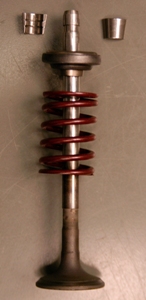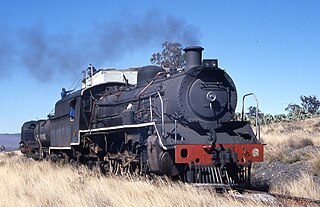
A poppet valve is a valve typically used to control the timing and quantity of petrol (gas) or vapour flow into or out of an engine, but with many other applications.

The valve gear of a steam engine is the mechanism that operates the inlet and exhaust valves to admit steam into the cylinder and allow exhaust steam to escape, respectively, at the correct points in the cycle. It can also serve as a reversing gear. It is sometimes referred to as the "motion".

The BR Standard Class 8 was a class of a single 4-6-2 Pacific steam locomotive designed by Robert Riddles for use by British Railways. Only the prototype was constructed, which was christened the name Duke of Gloucester. Constructed at Crewe Works in 1954, the Duke, as it is popularly known, was a replacement for the destroyed LMS Princess Royal Class locomotive number 46202 Princess Anne, which was involved in the Harrow and Wealdstone rail crash of 1952.

The British Railways Standard Class 5MT4-6-0 is one of the 12 BR standard classes of steam locomotive built by British Railways in the 1950s. It was essentially a development of the LMS Stanier Class 5 4-6-0. A total of 172 were built between 1951 and 1957.
The Pennsylvania Railroad's class K5 were experimental 4-6-2 "Pacific" types, built in 1929 to see if a larger Pacific than the standard K4s was worthwhile. Two prototypes were built, #5698 at the PRR's own Altoona Works, and #5699 by the Baldwin Locomotive Works. Although classified identically, the two locomotives differed in many aspects, as detailed below. They were both fitted with a much fatter boiler than the K4s, but dimensionally similar to those of the I1s 2-10-0 "Decapods". Most other dimensions were enlarged over the K4s as well; the exceptions being the 70 square feet (6.5 m2) grate area and the 80 in (2.032 m) drivers.

The Stephenson valve gear or Stephenson link or shifting link is a simple design of valve gear that was widely used throughout the world for various kinds of steam engines. It is named after Robert Stephenson but was invented by his employees.

British Railways built twenty locomotives of the LMS Stanier Black Five type, fitted with Caprotti valve gear, in 1948; the BR Caprotti Black Fives. These were numbered 44738-57, 44686 and 44687. The Black Fives had been fitted with Walschaerts valve gear as standard. In 1947, as part of an experimental programme by George Ivatt to try to improve the already good design, (4)4767 was built with Stephenson link motion. The Caprotti-fitted Black Fives were part of the same programme.

The North Eastern Railway Class S3, classified B16 by the LNER, was a class of 4-6-0 steam locomotive designed for mixed traffic work. It was designed by Vincent Raven and introduced in 1920. The earlier members of this class were fitted with Westinghouse Brakes - all of this equipment was removed during the 1930s.
Edward Thompson was an English railway engineer, and was Chief Mechanical Engineer of the London and North Eastern Railway between 1941 and 1946. Edward Thompson was born at Marlborough, Wiltshire on 25 June 1881. He was the son of Francis Thompson, assistant master at Marlborough College. He was educated at Marlborough before taking the Mechanical Science Tripos at Pembroke College, Cambridge, earning a third class degree. Thompson entered the railway scene after education, contrasting that of his predecessor Nigel Gresley, who had also attended Marlborough after gaining practical experience as a pupil at Horwich Works.

The London and North Eastern Railway Class P2 was a class of 2-8-2 steam locomotives designed by Sir Nigel Gresley for working heavy express trains over the harsh Edinburgh to Aberdeen Line. As they were to serve on Scottish expresses, they were given famous names from Scottish lore.
Henry Greenly (1876–1947) was amongst the foremost miniature railway engineers of the 20th century, remembered as a master of engineering design.

Piston valves are one form of valve used to control the flow of steam within a steam engine or locomotive. They control the admission of steam into the cylinders and its subsequent exhausting, enabling a locomotive to move under its own power. The valve consists of two piston heads on a common spindle moving inside a steam chest, which is essentially a mini-cylinder located either above or below the main cylinders of the locomotive.

The London and North Western Railway (LNWR) Claughton Class was a class of 4-cylinder express passenger 4-6-0 steam locomotives.

The South African Railways Class 19C 4-8-2 of 1935 was a steam locomotive.

The South African Railways Class 19B 4-8-2 of 1930 was a steam locomotive.

The GCR Class 8B was a class of 27 two-cylinder steam locomotives of the 4-4-2 wheel arrangement built between 1903 and 1906 for the Great Central Railway. They were nicknamed "Jersey Lillies" after the famous music star Lillie Langtry.

Heenan & Froude was a United Kingdom-based engineering company, founded in Newton Heath, Manchester, England in 1881 in a partnership formed by engineers Richard Froude and Richard Hammersley Heenan. Expanded on the back of William Froude's patent for inventing the water brake dynamometer, their most famous creation was the 518 feet (158 m) high Blackpool Tower.

GCR Class 9P was a design of four-cylinder steam locomotive of the 4-6-0 wheel arrangement built for hauling express passenger trains on the Great Central Railway in England. A total of six were built: one in 1917, and five in 1920. They were sometimes known as the Lord Faringdon class, from the name of the first one built.

A double chimney is a form of chimney for a steam locomotive, where the conventional single opening is duplicated, together with the blastpipe beneath it. Although the internal openings form two circles, the outside appearance usually forms a single elongated oval.

















